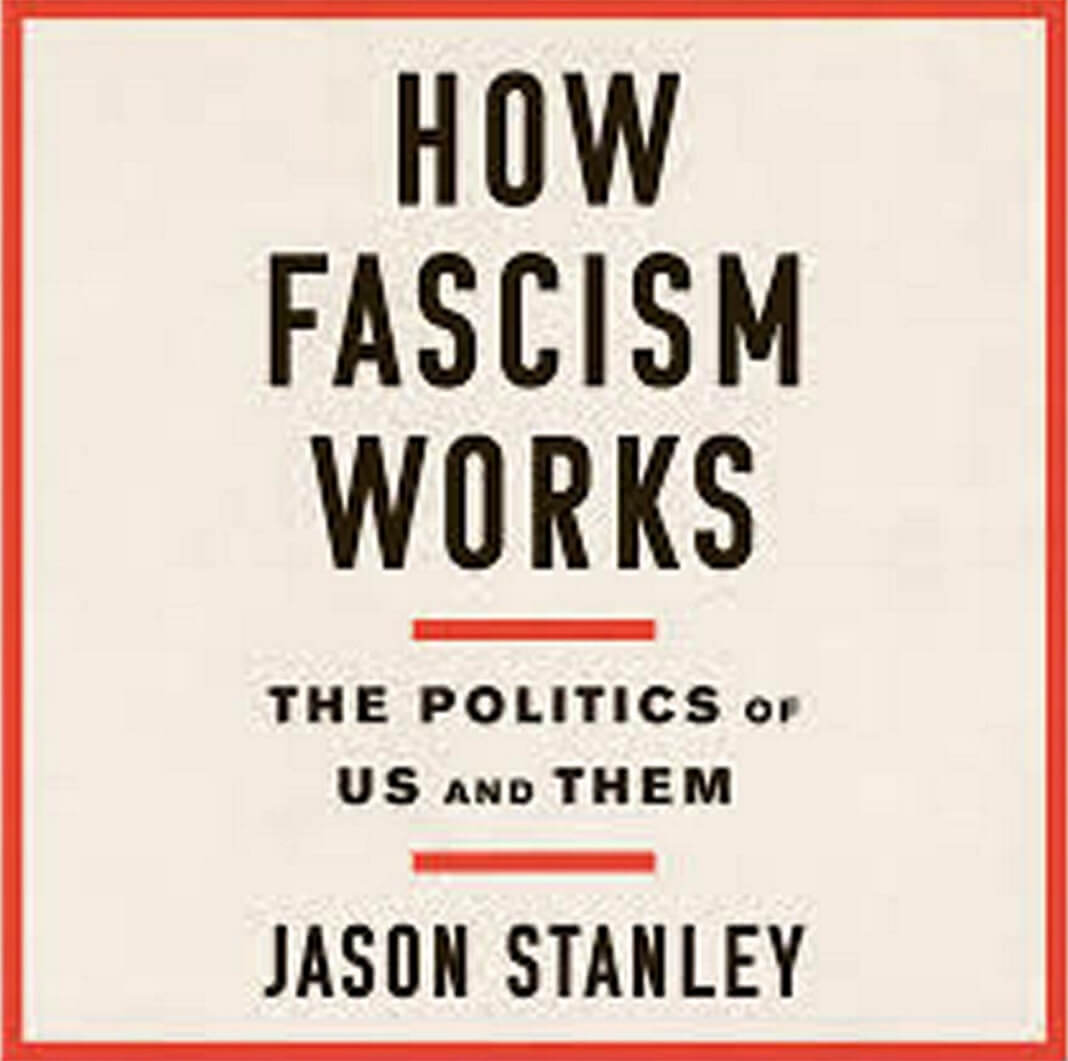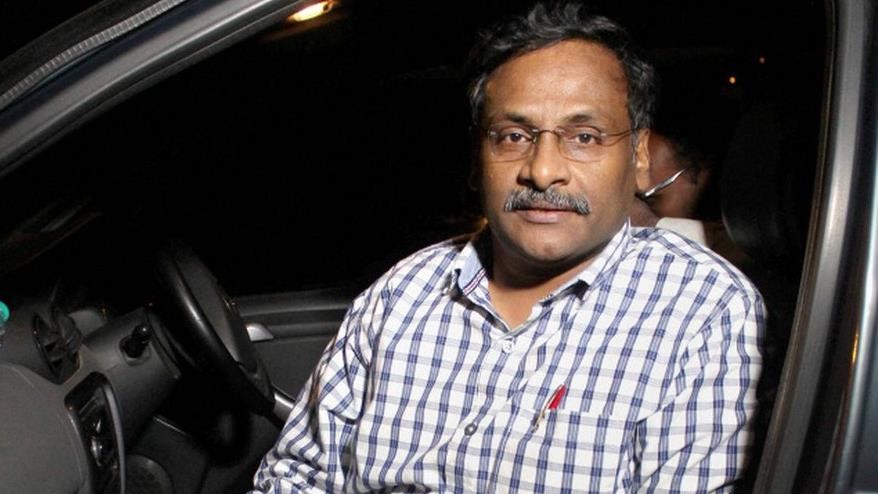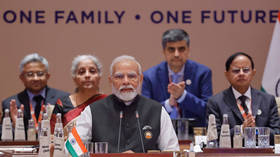Posted by: Sammi Ibrahem,Sr

WE know that fascism differs from totalitarian dictatorship in that fascism is a movement, enjoying the support and participation of a significant section of people. How Fascism Works: The Politics of Us and Them, a 2018 book by Professor Jason Stanley, deftly identifies ten key methods used by fascist politicians to achieve such support. Rich with examples from history as well as contemporary world politics, this book helps us analyse India’s contemporary reality. Reading this book, we can easily see how Modi’s regime takes many a leaf from the fascist copybook. Liberation will summarise the ten features of fascist politics identified in this book, with brief notes on how the Modi regime and the RSS and BJP politics tick those ten boxes.
I – The Mythical Past
In this chapter Stanley discusses the BJP’s own use of this tactic of constructing a mythical past. He quotes a 1922 speech at the Fascist Congress in Naples, where Benito Mussolini declared:
We have created our myth. The myth is a faith, a passion. It is not necessary for it to be a reality….Our myth is the nation, our myth is the greatness of the nation! And to this myth, this greatness, which we want to translate into a total reality, we subordinate everything.
Stanley observes, “Here, Mussolini makes clear that the fascist mythic past is intentionally mythical. The function of the mythic past, in fascist politics, is to harness the emotion of nostalgia to the central tenets of fascist ideology—authoritarianism, hierarchy, purity, and struggle.” Stanley adds, “The fascist mythic past exists to aid in changing the present.”
Stanley’s observations on the centrality of the patriarchal family in the fascist myth are especially relevant to the RSS tactics in India. Stanley observes:
“The patriarchal family is one ideal that fascist politicians intend to create in society—or return to, as they claim. The patriarchal family is always represented as a central part of the nation’s traditions, diminished, even recently, by the advent of liberalism and cosmopolitanism. But why is patriarchy so strategically central to fascist politics?
In a fascist society, the leader of the nation is analogous to the father in the traditional patriarchal family. The leader is the father of his nation, and his strength and power are the source of his legal authority, just as the strength and power of the father of the family in patriarchy are supposed to be the source of his ultimate moral authority over his children and wife. The leader provides for his nation, just as in the traditional family the father is the provider. …By representing the nation’s past as one with a patriarchal family structure, fascist politics connects nostalgia to a central organizing hierarchal authoritarian structure, one that finds its purest representation in these norms.”
In an essay titled ‘India’s Democracy: Contest For The Nation’s Core’, (Indian Democracy Origins, Trajectories, Contestations, Edited by Alf Gunvald Nilsen, Kenneth Bo Nielsen and Anand Vaidya, Pluto Press, 2019), Liberation editor Kavita Krishnan noted how the RSS deploys metaphors of home (ghar) and its sister-term family (parivar) “to valorise the patriarchal family and subjugation of women – even to the extent of justifying wife-beating as necessary chastisement of erring wives.” She pointed out that “Leaders of the Rashtra Sevika Samiti, the RSS’s women’s wing, describe themselves as “familyist not feminist”, and feminist assertions of women’s autonomy are painted as Western-inspired disruptions of the harmonious Indian family. Oppressive social practices are all rationalised as having evolved to “protect” women from rapacious Muslims.” Moreover, “Ghar is also invoked to describe Hinduism as the home for Dalits and Muslims, and to prescribe and order ghar wapsi, a return to the home of those who have converted to other faiths. Parivar is used to recast relations between workers and bosses as harmonious relations within the “industry family”, thus justifying erosion and dilution of labour laws. …Labour laws and unionising are cast as disruptions of the “industry family”. Parivar is also used to recast India as the global home of Hindus in the draft Citizenship Amendment Bill…a Hindu Rashtra Bill by the backdoor, seeking to cast Hindus as having a greater natural right to citizenship than non-Hindus.”
Stanley comments on the debt owed by the RSS to European fascists Hitler and Mussolini:
“According to adherents of the Hindutva movement in India, Hindus were the indigenous population of India, living according to patriarchal customs and with strict puritanical sexual practices until the arrival of Muslims, and subsequently, Christians, who introduced decadent Western values. The Hindutva movement has fabricated a version of a mythic Indian past with a pure nation of Hindus, to dramatically supplement what is regarded by scholars as the actual history of India. India’s dominant nationalist party, Bharatiya Janata Party (BJP), adopted Hindutva ideology as its official creed and won power in the country using emotional rhetoric calling for a return to this fictional, patriarchal, harshly conservative, ethnically and religiously pure past. BJP is descended from the political arm of Rashtriya Swayamsevak Sangh (RSS), an extremist, far-right Hindu nationalist party that advocated the suppression of non-Hindu minorities. Nathuram Godse, the man who assassinated Gandhi, was a member of RSS, as was current Indian prime minister Narendra Modi. RSS was explicitly influenced by European fascist movements, its leading politicians regularly praised Hitler and Mussolini in the late 1930s and 1940s.”
But if the fascists glorify and mythologise the past, why do they run down historians and historical research so much? Stanley offers this insight:
“The strategic aim of these hierarchal constructions of history is to displace truth, and the invention of a glorious past includes the erasure of inconvenient realities. While fascist politics fetishizes the past, it is never the actual past that is fetishized. These invented histories also diminish or entirely extinguish the nation’s past sins. It is typical for fascist politicians to represent a country’s actual history in conspiratorial terms, as a narrative concocted by liberal elites and cosmopolitans to victimize the people of the true “nation.”
This fits in exactly with what the RSS does to India’s best historians, and to history-writing in India.
II – Propaganda
Why do fascists need propaganda? Stanley writes: “It’s hard to advance a policy that will harm a large group of people in straightforward terms. The role of political propaganda is to conceal politicians’ or political movements’ clearly problematic goals by masking them with ideals that are widely accepted.”
Anti-corruption is a favourite plank for fascists. Referring to Trump’s (false) claims of “draining the swamp” (i.e cleansing Washington of corrupt corporate lobbyists), Stanley writes that “Fascist movements have been “draining swamps” for generations.”
Stanley notes that “anticorruption campaigns are frequently at the heart of fascist political movements. Fascist politicians characteristically decry corruption in the state they seek to take over, which is bizarre, given that fascist politicians themselves are invariably vastly more corrupt than those they seek to supplant or defeat.” This is certainly true of Modi and the BJP, who rode to power in the wake of the Anna Hazare-led anti-corruption movement, but have proved to be vastly more corrupt than the UPA Government they ousted.
The historian Richard Grunberger’s observations on the Nazis in his book The 12-Year Reich, cited by Stanley, sound uncannily familiar to us in India today:
“Having dinned it into the collective consciousness that democracy and corruption were synonymous, the Nazis set about constructing a governmental system beside which the scandals of the Weimar regime seemed small blemishes on the body politic. Corruption was in fact the central organizing principle of the Third Reich—and yet a great many citizens not only overlooked this fact, but actually regarded the men of the new regime as austerely dedicated to moral probity.”
The Modi Government’s erosion of the independence of the press, the judiciary, the Election Commission and various investigative and watchdog agencies is also a favourite fascist tactic. Stanley writes, “In the name of rooting out corruption and supposed bias, fascist politicians attack and diminish the institutions that might otherwise check their power.”
The mere fact that Trump, Modi and Bolsonaro were elected, does not make them less fascist. According to Stanley, “Historically, fascist leaders have often come to power through democratic elections. But the commitment to freedom, such as the freedom inherent in the right to vote, tends to end with that victory.”
A quote from the Nazi propaganda minister Joseph Goebbels, cited by Stanley is a particularly striking: “This will always remain one of the best jokes of democracy, that it gave its deadly enemies the means by which it was destroyed.”
III: Anti-Intellectual
The vicious attacks by Sangh stormtroopers and police on JNU, DU, Jadavpur University, HCU, Jamia and AMU are very much in line with the classic fascist modus operandi.
When the Modi regime was reelected in May 2019, BJP General Secretary Ram Madhav wrote a triumphant op-ed saying that in this second term, liberals would “be discarded from the country’s academic, cultural and intellectual landscape.” Stanley puts his finger on why the Sangh and BJP are equally invested in saffronising syllabi and schools while attacking and destroying liberal campuses: “Education … either poses a grave threat to fascism or becomes a pillar of support for the mythical nation. It’s no wonder, then, that protests and cultural clashes on campuses represent a true political battleground and receive national attention. The stakes are high….Fascist politics seeks to undermine the credibility of institutions that harbor independent voices of dissent until they can be replaced by media and universities that reject those voices.”
Stanley’s description of the fascist animus towards intellectuals sounds like a description of the Sangh’s attacks on JNU and what they deride as the ‘award-wapsi gang’, ‘Khan Market cabal’ or ;urban Naxals’ today:
“Whenever fascism threatens, its representatives and facilitators denounce universities and schools as sources of “Marxist indoctrination,” the classic bogeyman of fascist politics. Typically used without any connection to Marx or Marxism, the expression is employed in fascist politics as a way to malign equality. That is why universities that seek to give some intellectual space to marginalized perspectives, however small, are subject to denunciation as hotbeds of “Marxism”…
Student protests are misrepresented in the press as riots by undisciplined mobs, threats to the civil order. In fascist politics, universities are debased in public discourse, and academics are undermined as legitimate sources of knowledge and expertise, represented as radical “Marxists” or “feminists” spreading a leftist ideological agenda under the guise of research. By debasing institutions of higher learning and impoverishing our joint vocabulary to discuss policy, fascist politics reduces debate to ideological conflict. Via such strategies, fascist politics degrades information spaces, occluding reality.”
The Sangh has always referred even to liberal historians as ‘Leftist’ or ‘Marxist’. And now all dissenting voices, even those of Gandhians, are referred to as ‘Maoist’ or ‘urban Naxal.’
IV: Unreality
In what sounds like a perfect description of ‘Modi-fied’ television in India today, Stanley writes, “Fascist politics transforms the news from a conduit of information and reasoned debate into a spectacle with the strongman as the star.”
V: Hierarchy
We have seen how the anxieties of the dominant Hindu upper caste men (the notion that they are ‘victims’ of caste-based reservations, that Muslims are ‘taking over’; and even that ‘men’s rights’ and ‘family’ need to be ‘saved’ from westernised women) have provided fertile grounds for the RSS. Stanley explains how this works:
“Hierarchy benefits fascist politics in another way: Those who are accustomed to its benefits can be easily led to view liberal equality as a source of victimization. Those who benefit from hierarchy will adopt a myth of their own superiority, which will occlude basic facts about social reality. They will distrust pleas for tolerance and inclusion made by liberals on the grounds that these pleas are masks for power grabs by other groups. Fascist politics feeds off the sense of aggrieved victimization caused by loss of hierarchal status.”
The caste system and Brahminical patriarchy in particular make Indian society more hierarchical than most – and therefore especially vulnerable to fascist politics.

VI: Victimhood
Stanley discusses how “increased representation of members of traditional minority groups is experienced by dominant groups as threatening in various ways.”
Here, Stanley helps make the distinction between anti-colonial nationalism and chauvinistic nationalism. He points out that “Anti-colonialist struggles typically take place under the banner of nationalism; for example, Mahatma Gandhi employed Indian nationalism as a tool against British rule. This kind of nationalism, the nationalism that arises from oppression, is not fascist in origin. These forms of nationalism, in their original formations, are equality-driven nationalist movements.”
However, Stanley rightly cautions: “Equality-driven nationalism can rapidly turn oppressive itself, if one is not paying enough attention to shifts in power. Some problematic nationalist sentiments arise from perfectly genuine histories of oppression.” This certainly applies to the ways in which the Indian and the Chinese states have deployed “nationalism” away from its original anti-colonial and egalitarian goal, to justify discrimination and repression. That India won freedom from colonial rule does not mean that Indians are not replicating colonial attitudes in Kashmir.
Stanley could well be talking about caste-based reservations which are attacked with the casteist argument of “merit” when he writes:
“Fascist politics covers up structural inequality by attempting to invert, misrepresent, and subvert the long, hard effort to address it. Affirmative action at its best was designed to recognize and address structural inequality. But by falsely presenting affirmative action as uncoupled from individual merit, some of its detractors recast advocates of affirmative action as pursuing their own race- or gender-based “nationalism” to the detriment of hardworking white Americans, regardless of evidence.”
In India, then, we need to make a distinction between an equality-driven nationalisms, and nationalisms that define themselves in contrast with vulnerable minorities cast in the role of the “dangerous Other.” The same nationality movements that are progressive when they assert themselves against a discriminatory and oppressive State, can themselves become communal and xenophobic when they cast the migrant labourer from linguistic and religious minorities as the enemy. As Stanley puts it:
“Nationalism is at the core of fascism. The fascist leader employs a sense of collective victimhood to create a sense of group identity that is by its nature opposed to the cosmopolitan ethos and individualism of liberal democracy. The group identity can be variously based—on skin color, on religion, on tradition, on ethnic origin. But it is always contrasted with a perceived other against whom the nation is to be defined. Fascist nationalism creates a dangerous “them” to guard against, at times to battle with, to control, in order to restore group dignity.”
VII: Law and Order
Stanley writes: “Fascist law-and-order rhetoric is explicitly meant to divide citizens into two classes: those of the chosen nation, who are lawful by nature, and those who are not, who are inherently lawless.”
This observation is especially useful to understand the BJP’s attempts to imply that all Muslims are inherently “infiltrators”, “troublemakers who can be identified by their clothes”, and “terrorists.”
VIII: Sexual Anxiety
In passages describing how fascist politics portrays the ‘Other’ as a source of sexual danger, Stanley specifically notes the connections between Nazi anti-Semitism in Germany, white supremacy in the US, and Islamophobia in Myanmar and India.
Stanley notes how “fascist propaganda” sexualizes “the threat of the other,” citing the example of Nazi policies against ‘race-mixing’, and the lynching of black men in the United States on the pretext of “defending the purity of white American women.”
He also notes how “the genocide against the Rohingyas” in Myanmar “has been fueled by paranoid theories” by Buddhist fascist groups about “Muslim sexual schemes to prey on Buddhist women.”
Stanley also discusses India in detail:
“In India, Hindu nationalists have regularly stoked anti-Muslim sentiment with campaigns calling attention to the supposed threat Muslim men pose to Hindu masculinity. Most recently, this took the form of a panic about a supposed “love jihad.”
The way in which the “law and order” and ‘love jihad’ rhetorics combine in Sangh propaganda are extremely apparent in BJP President Amit Shah’s speeches in western UP in 2014, where he justified anti-Muslim violence by saying, “when a community violates the honour of our daughters and sisters, and the administration does nothing, people are forced to riot.” ( ‘Amit shah’s Hate speech at Jat sabha in Shamli, West UP’, posted by NewsClick, YouTube, 7 April 2014, https://www.youtube.com/watch?v=ttk_ZYdevoM)
India is going through a Modi-made economic disaster and unemployment crisis. While this can and does translate into anger against the Modi regime, the RSS and BJP try hard to use patriarchal sentiments to turn the anger against “a community that violates the honour of our daughters and sisters” or against feminists and women students who are described as purveyors of “free sex”. Women’s freedom and inter-faith love are both demonised by the Sangh as threats to the caste and patriarchal hierarchy.
Stanley’s analysis helps us understand why and how. He writes:
“Patriarchal masculinity sets up men with the expectation that society will allow them the role of sole protectors and providers of their families. …Fascist politics distorts male anxiety, heightened by economic anxiety, into fear that one’s family is under existential threat from those who reject its structure and traditions. Here again, the weapon used in fascist politics is a supposed potential threat of sexual assault.”
IX: Vilifying Urban Cosmopolitanism
Why did Mohan Bhagwat blame rape on cities? Perhaps because the Sangh seeks to appeal to hierarchical rural communities by displacing their natural resentment at marginalisation and crisis unleashed by neoliberal policies, onto liberal urban campuses, intellectuals and youth who are portrayed as ‘elite’ and morally corrupt.
Stanley explains: “Fascist politics highlights the wrongs a globalized economy does to rural areas, adding to it a focus on traditional rural values of self-sufficiency supposedly put at risk by the success of liberal cities culturally and economically.
Fascist ideology rejects pluralism and tolerance. …The diversity, with its concomitant tolerance of difference, in large urban centers is therefore a threat to fascist ideology.”
Ironically while fascist politicians may portray JNU and DU students, and trade union activists like Sudha Bharadwaj as liberal ‘Khan Market’ elites, they describe their own stupendously corrupt, super-rich corporate cronies (Ambanis and Adanis) as ‘wealth generators’ rather than elites!
X: Work Sets You Free
Remember how BJP MP Tejasvi Surya jeers at Muslims as ‘puncture repair walas’, and Amit Shah refers to them as ‘termites’ (i.e parasites)? Stanley’s writing could help explain why they deploy such rhetoric:
“In fascist ideology, in times of crisis and need, the state reserves support for members of the chosen nation, for “us” and not “them.” The justification is invariably because “they” are lazy, lack a work ethic, and cannot be trusted with state funds and because “they” are criminal and seek only to live off state largesse. In fascist politics, “they” can be cured of laziness and thievery by hard labor. This is why the gates of Auschwitz and Buchenwald had emblazoned on them the slogan ARBEIT MACHT FREI—work shall make you free. In fascist ideology, the ideal of hard work is weaponized against minority populations.”
Stanley offers an important insight about the relationships between libertarian and fascist ideology:
“The fascist vision of individual freedom is similar to the libertarian notion of individual rights—the right to compete but not necessarily to succeed or even survive…. Though fascism involves a commitment to group hierarchies of worth that is flatly incompatible with true economic libertarianism, which does not generalize beyond the individual, both philosophies share a common principle by which value is measured.”
Remember how the BJP tries to recast the labour-boss relationship as the ‘Industry Family’? Turns out that too is a classic fascist ploy which also shares much with corporate ideology. Stanley observes:
“Hitler was correct that in a democratic society, there are tensions between the varied practices and structures of families, workplaces, government bodies, and civil society. Fascism promises to solve this by eliminating such differences. Instead, in fascist ideology, all institutions, from the family to the business to the state, would run according to the Führer Principle. The father, in fascist ideology, is the leader of the family; the CEO is the leader of the business; the authoritarian leader is the father, or the CEO, of the state. When voters in a democratic society yearn for a CEO as president, they are responding to their own implicit fascist impulses.”
Epilogue
Is it not an exaggeration to claim India is descending into fascism? This is a question that is often asked, especially by liberal commentators who still want to claim that things are not so bad. In the epilogue, Stanley discusses this issue:
“What normalization does is transform the morally extraordinary into the ordinary. It makes us able to tolerate what was once intolerable by making it seem as if this is the way things have always been. By contrast, the word “fascist” has acquired a feeling of the extreme, like crying wolf. …Normalization means precisely that encroaching ideologically extreme conditions are not recognized as such because they have come to seem normal. The charge of fascism will always seem extreme; normalization means that the goalposts for the legitimate use of “extreme” terminology continually move.”
The book which outlines fascist tactics and acknowledges how powerful and persuasive fascist politics can be, still ends on a note of hope. As we look around us at the movement that has sprung up against the NPR-NRC-CAA, we may cautiously say that we, in India too, must nurture some of this hope.
Stanley writes:
“How do we maintain a sense of common humanity, when fear and insecurity will lead us to flee into the comforting arms of mythic superiority in vain pursuit of a sense of dignity? …We can take comfort in the histories of progressive social movements, which against long odds and hard struggle have in the past succeeded in the project of eliciting empathy.
“In the direct targets of fascist politics—refugees, feminism, labor unions, racial, religious, and sexual minorities—we can see the methods used to divide us. But we must never forget that the chief target of fascist politics is its intended audience, those it seeks to ensnare in its illusory grip, to enroll in a state where everyone deemed “worthy” of human status is increasingly subjugated by mass delusion.”
This is perhaps the insight that resonates most in these times. While Muslims are certainly the most vulnerable targets of the NPR-NRC-CAA, we must never forget that the non-Muslims who are the intended audience for its Islamophobic hate-speech, are also targets and victims whom the Modi regime is seeking to delude. NPR-NRC-CAA will place the vast majority of Indians (including the non-Muslim poor) at the mercy of an all-powerful State that can control them with the ever-present threat of marking them as “doubtful citizens” and stripping them of citizenship and humanity. So Stanley warns against demonising even the majority who have become loyal bhakts of the Trumps and Modis:
“Those not included in that audience and status wait in the camps of the world, straw men and women ready to be cast into the roles of rapists, murderers, terrorists. By refusing to be bewitched by fascist myths, we remain free to engage one another, all of us flawed, all of us partial in our thinking experience, and understanding, but none of us demons.”



